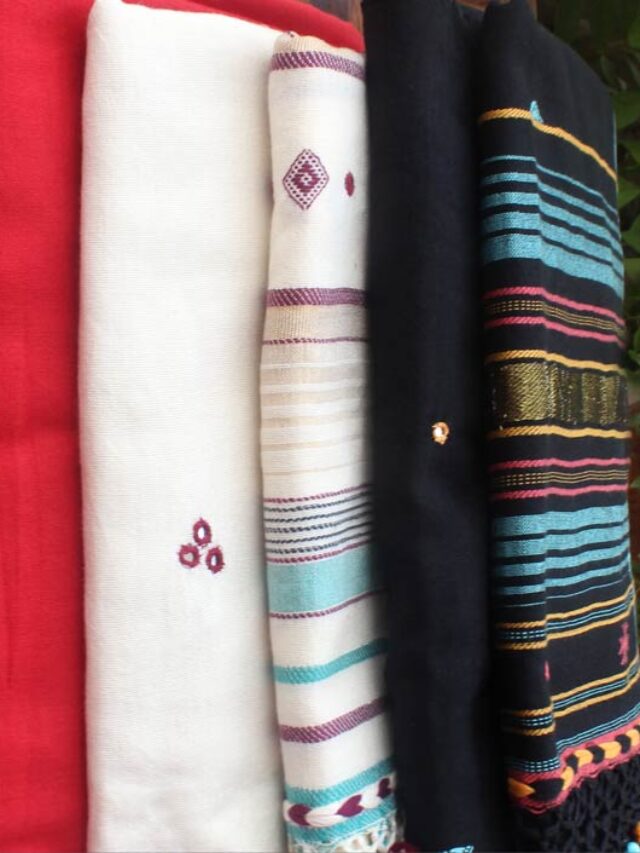Bhuj the capital of former native state of Kutch, is now the head quarter of the Kutch district, is known for its weaving technique “BHUJODI”. This Artistic weaving of Bhuj is well-liked for its traditional designs & use of primary color combination as well for its value as part of cultural heritage.(1)
Kala cotton is an indigenous, organic, rain-fed crop growing in eastern Kutch, Gujarat. Fifty years earlier, farming and weaving were the only two professions of Bhujodi inhabitants, each carried on for half the year. The Vankar (weavers) community reclaimed itself to emerge as a hub for handloom cotton and woollen textiles (2)
The nomadic cattle herders and shepherds “The Rabari tribe”, believed to have travelled across the mountains of Afghanistan and settled in Rajasthan about a thousand years ago, is responsible for their distinct weaving tradition in Bhujodi. The ‘Rabaris,’ supplied the village with wool, milk products, and grains, while the while the Vankars weaved clothes in exchange of those supplies. Dhabla is one of earlies woolen items woven that can be used both as blanket and shawl. it is distinguished by highly visible motifs that are woven and create bold textures on the background-plain fabric, giving the impression of embroidery(3)
Weaving in Bhujodi is done on the age-old pit looms with a very simple setup. Each wooden part of the loom is locally made by the carpenters for the Vankar community. The reed called Fani (फणी) is also handmade with bamboo sticks with gaping according to the thick or thinness of the yarn to be used. The four shafts (called Ranchh राच्छ) are hand made with nylon threads (substitute of cotton for long-lasting use) looped around sticks. The whole weaving process is a rhythmic movement of all these parts of the loom managed by the weaver. Both his legs manage four paddles for shedding while his arms are busy with the movement of the shuttle for the weft picks simultaneously. Almost every household in the Bhujodi village has a dedicated space for their looms. These spaces are mostly open and shaded small areas in a corner of the varanda with clean mud flooring.(6)
Popular motifs of Bhujodi Weaving
Bhujodi weavers traditionally woven shawls and used goat, sheep, and camel wool, but now use of silk, acrylic, and cotton is also common along with expansion of the product line to include sarees, dress-material and dupattas
Although on one hand interest in crafts has led to its popularity, on the other it has led to the reduced skill level of artisans, as the artisans now reproduce simpler designs for an “volatile” market. These mainstream craft narratives in the fashion industry focus largely on innovation and reformation through new technology and modernisation of traditional practice, shifting the ownership of craft knowledge from practitioners to designers, creating hierarchy in the system, stripping the artisans of their knowledge and failing to appreciate their creative sphere, to consider them not just as technical experts or skilled labour but appreciate their intangible knowledge (5)
SUPPORT, ENCOURAGE AND ENJOY THE GOODNESS OF INDEGENOUS CLOTHES
SOURCE
- 1. A STUDY ABOUT MOTIFS & YARNS USED IN ARTISTIC WEAVING OF KUTCH DISTRIC
- 2. Kala Cotton: A Sustainable Alternative
- 3. Exploring the Artisanal Heritage and Sustainable Practices: An In-Depth Investigation into the Traditional Craftsmanship and Contemporary Significance of Bhujodi Weaves Hypothesis
- 4. Kala Cotton: India’s old world organic cotton
- 5. Who are the Artisans: A case for their creative and cultural identities
- 6. BHUJODI WEAVE – THE TURBAN WEAVERS OF BHUJODI

